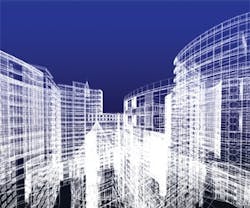Newsworthy
As building practices and technologies advance, it’s important to introduce consistency across sets of drawings to keep the industry efficient and at the top of its game. The American Institute of Architects (AIA), the Construction Specifications Institute (CSI), and the National Institute of Building Sciences have been working on this for years, and, as a result, introduced the latest version of the U.S. National CAD Standard (NCS) – Version 4.0 – in January 2008.
It was created to be a flexible, voluntary standard to help organizations lower costs by reducing errors and change orders, and improving communication among team members. It also increases productivity and reduces training time.
Last month, a new revision cycle was opened to members of the NCS project committees. Designed to keep the NCS current and responsive to industry needs, the revision cycle allows members to propose, debate, and vote on NCS changes and improvements. Version 4.0 users are encouraged to participate, and input is needed to help shape the next version.
The current version features many improvements for users, and work is being done so the next version incorporates aspects of BIM via file naming conventions and other features to integrate model-based designs and drawing-based systems and output. As the next version develops, the National BIM Standard will be incorporated to make BIM and CAD more integrated.
Version 4.0 can be downloaded in PDF format, and includes specific sections in Excel and DWG formats. The Excel files include example spreadsheets that depict the schedules shown throughout the NCS, and searchable spreadsheets for layer disciplines and groups. The DWG files consist of more than 1,000 samples from the Symbols module, which include everything from drawing block titles to manholes to tree symbols.
To learn more about the revision process, or to become a member of a project committee, visit www.nationalcadstandard.org.
Melcher Mack leads Bergmann Associates’ Computer Aided Design (CAD) & Design Technology Group.
Nursing Home Residents are Healthier and Happier When Empowered to Choose Décor
Research from Ambius (which offers interior landscaping, design installation, and maintenance) and the University of Exeter shows that nursing home residents who were able to make design choices about their surroundings felt healthier, happier, and more satisfied. The research was carried out at a senior living facility operated by Somerset Care, and sought to determine whether residents would make greater use of communal facilities that were refurnished with their choice of plants and artwork.
In comparison to their peers, the study found that residents who were allowed to make design choices used their lounge space more than twice as often (217 percent), were 40-percent more satisfied with their lives, were 46-percent more comfortable in their living areas, and reported themselves to be 43-percent happier.
The residents who chose their own décor steered away from floral patterns and pastel colors, and went instead for modern prints, bold colors, and “architectural” plant displays (presumably because bold colors and shapes are more visible against the background, and they stood out to those with lessened visual senses).
Green Building Will Support Nearly 8 Million U.S. Jobs
A new study from the U.S. Green Building Council and Booz Allen Hamilton shows that green building will support 7.9 million jobs in the United States, and will pump $554 billion (including $396 billion in wages) into the American economy between now and 2013.
Additionally, the study determined that green construction spending currently supports more than 2 million American jobs and generates more than $100 billion in gross domestic product and wages. And, from 2000 to 2008, the green construction market contributed $178 billion to U.S. gross domestic product; created or saved 2.4 million direct, indirect, or induced jobs; and generated $123 billion in wages.
“The study demonstrates that investing in green buildings contributes significantly to the nation’s wealth while creating jobs in a range of occupations,” says Gary Rahl of Booz Allen Hamilton.
Rockdale Medical Center Receives ENERGY STAR Label
COURTESY OF ROCKDALE MEDICAL CENTER
Rockdale Medical Center in Conyers, GA, is the first and only hospital in Georgia with the ENERGY STAR label for superior energy efficiency.
Several renovations have taken place in the 560,000-square-foot building since it was constructed in 1977 – the most recent being the 290,464-square-foot East Tower expansion, which houses The Birth Place, the ICU, the Women’s Diagnostic Center, and more. Optimization of the hospital’s HVAC system through automation helped the hospital increase its ENERGY STAR rating from 72 to 89. Additionally, the air-handling equipment was adjusted in conjunction with the outside weather conditions to reduce energy usage. The result of this increased energy efficiency: $365,000 in annual savings on utility costs.
Atlanta Botanical Garden Undergoes Green Renovation and Expansion
©KIERAN REYNOLDS
One of the top 10 public gardens in the United States – Atlanta Botanical Garden – has undergone a $55 million green expansion that includes a new visitor center and a 750-car, 7-story parking facility. The project, which demonstrates commitment to environmental stewardship, is currently pending LEED certification.
The visitor center is nestled into a hillside to aid in natural heating and cooling insulation, providing 30-percent energy savings over standard guidelines, and is strategically designed to integrate into natural surroundings to preserve the natural terrain. A green roof covering 35 percent of the roof surface provides a natural green barrier to reduce heat gain and energy usage, and it offers a new wildlife area.
NASA Strikes Gold
PHOTO COURTESY OF LPA INC./COSTEA PHOTOGRAPHY
NASA’s Jet Propulsion Laboratory’s (JPL) new Flight Projects Center achieved LEED Gold, making it the greenest facility in the NASA family.
The building includes numerous other sustainable features:
- Low-flow faucets and toilets, which will reduce water usage by 44 percent compared to typical fixtures.
- A vegetative roof.
- Outdoor lights, which will be directed at the ground to reduce light pollution.
- Daylighting and lighting controls.
- Smart heating and cooling systems.
- Use of green cleaning products.
